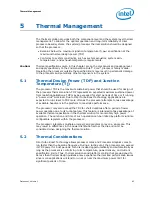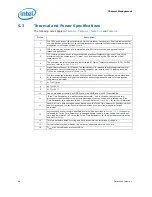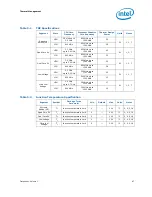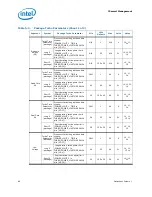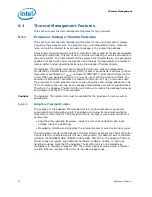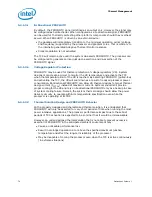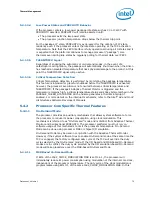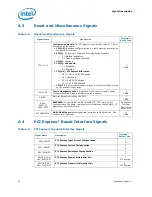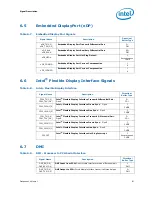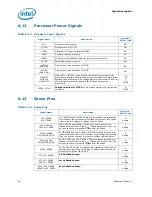
Thermal Management
74
Datasheet, Volume 1
5.4.1.3.1
Bi-Directional PROCHOT#
By default, the PROCHOT# signal is defined as an output only. However, the signal may
be configured as bi-directional. When configured as a bi-directional signal, PROCHOT#
can be used for thermally protecting other platform components should they overheat
as well. When PROCHOT# is driven by an external device:
• the package will immediately transition to the minimum operation points (voltage
and frequency) supported by the processor and graphics cores. This is contrary to
the internally-generated Adaptive Thermal Monitor response.
• Clock modulation is not activated.
The TCC will remain active until the system de-asserts PROCHOT#. The processor can
be configured to generate an interrupt upon assertion and de-assertion of the
PROCHOT# signal.
5.4.1.3.2
Voltage Regulator Protection
PROCHOT# may be used for thermal protection of voltage regulators (VR). System
designers can create a circuit to monitor the VR temperature and activate the TCC
when the temperature limit of the VR is reached. By asserting PROCHOT# (pulled-low)
and activating the TCC, the VR will cool down as a result of reduced processor power
consumption. Bi-directional PROCHOT# can allow VR thermal designs to target thermal
design current (I
CCTDC
) instead of maximum current. Systems should still provide
proper cooling for the VR and rely on bi-directional PROCHOT# only as a backup in case
of system cooling failure. Overall, the system thermal design should allow the power
delivery circuitry to operate within its temperature specification even while the
processor is operating at its TDP.
5.4.1.3.3
Thermal Solution Design and PROCHOT# Behavior
With a properly designed and characterized thermal solution, it is anticipated that
PROCHOT# will only be asserted for very short periods of time when running the most
power intensive applications. The processor performance impact due to these brief
periods of TCC activation is expected to be so minor that it would be immeasurable.
However, an under-designed thermal solution that is not able to prevent excessive
assertion of PROCHOT# in the anticipated ambient environment may:
• Cause a noticeable performance loss.
• Result in prolonged operation at or above the specified maximum junction
temperature and affect the long-term reliability of the processor.
• May be incapable of cooling the processor even when the TCC is active continuously
(in extreme situations).
Содержание 2ND GENERATION CORE PROCESSOR FAMILY DESKTOP - VOLUME 1 01-2011
Страница 10: ...10 Datasheet Volume 1 Revision History Revision Number Description Date 001 Initial Release January 2011 ...
Страница 22: ...Introduction 22 Datasheet Volume 1 ...
Страница 62: ...Power Management 62 Datasheet Volume 1 ...
Страница 86: ...Signal Description 86 Datasheet Volume 1 ...
Страница 106: ...Electrical Specifications 106 Datasheet Volume 1 ...
Страница 172: ...DDR Data Swizzling 172 Datasheet Volume 1 ...




